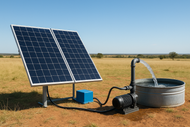Solar Water Pump for Remote Locations: Complete Selection & Sizing Guide
Posted by SolarTown on 18th Oct 2025
Solar Power for Water Pumps: Complete Guide to Solar-Powered Water Pumping Systems
Access to reliable, clean water remains one of humanity’s greatest challenges, with over 2 billion people lacking access to safely managed drinking water. Traditional water pumping solutions often rely on expensive grid electricity or diesel fuel, making them cost-prohibitive for remote communities and individual users. Solar power for water pump systems offers a revolutionary solution, harnessing the sun’s energy to provide sustainable, cost-effective water access wherever it’s needed most.
This comprehensive guide explores everything you need to know about solar powered water pumps, from basic operating principles to real-world applications that are transforming lives across the globe. Whether you’re considering solar irrigation for your farm, seeking an off-grid well pump solution, or exploring sustainable water access options, you’ll find the technical insights and practical guidance needed to make informed decisions.
What is Solar Power for Water Pumps
Solar power for water pump systems represent a breakthrough in sustainable water technology, converting abundant sunlight directly into electricity to power water pumping operations. These innovative systems use solar panels to generate direct current (DC) electricity from photons, which then powers a pump motor to lift water from underground sources, rivers, or other water bodies to where it’s needed.
The fundamental principle behind solar powered pumps involves photovoltaic panels that capture solar energy and convert it into electrical power. This electricity drives a pump motor, which operates the pumping mechanism to move water through piping systems to storage tanks, irrigation networks, or direct-use applications. Unlike traditional grid-powered systems, solar water pump installations operate independently of electrical infrastructure, making them ideal for remote locations where extending power lines would be prohibitively expensive.
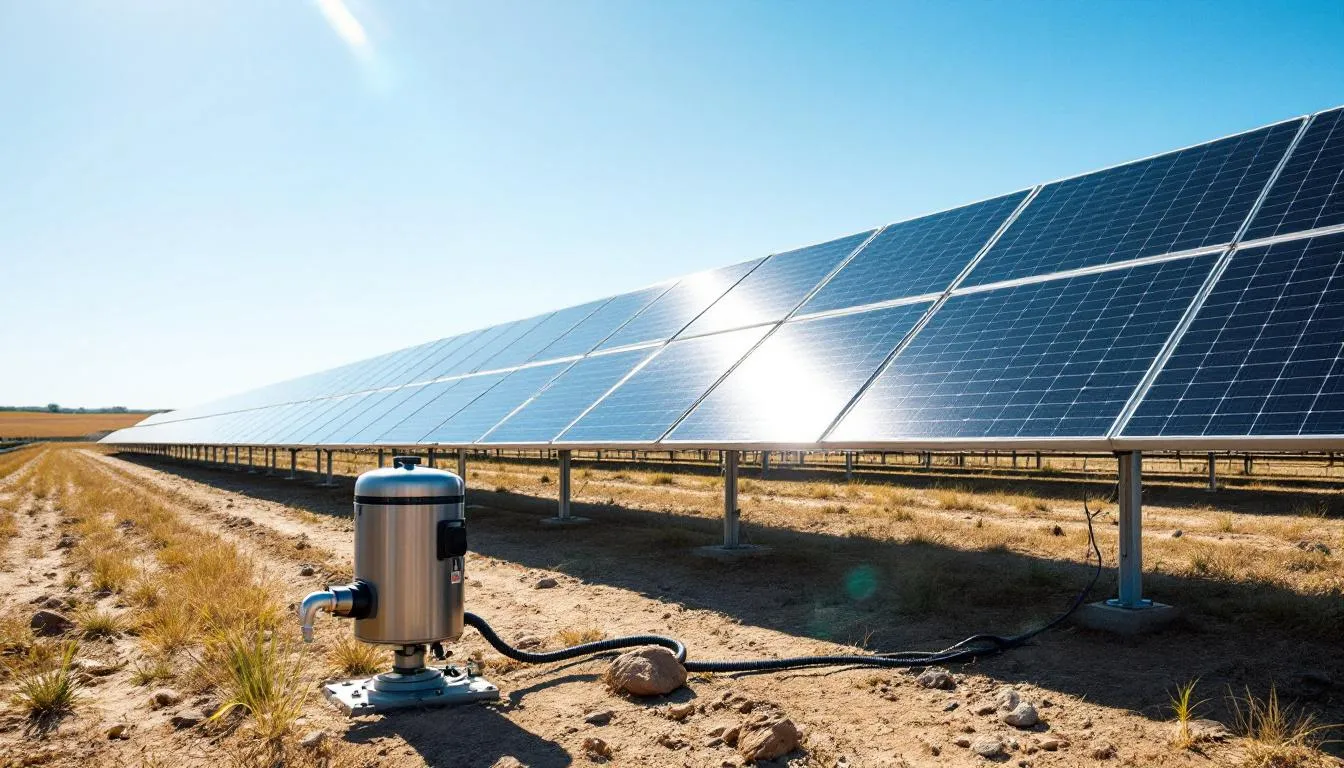
Solar powered water pumps serve diverse applications across agricultural, residential, and community settings. Farmers use these systems for crop irrigation, ensuring reliable water supply even during dry seasons. Rural homeowners rely on solar well pumps to access groundwater for household use. Livestock operations depend on solar powered pumps to provide consistent water access across remote grazing areas. Community projects in developing regions utilize solar water systems to deliver clean water to villages previously dependent on distant, contaminated sources.
The technology has evolved significantly from early small-scale applications to robust systems capable of handling high-volume pumping requirements. Modern solar water pump systems can deliver thousands of liters per hour while maintaining reliable operation across varying weather conditions and seasonal changes.
How Solar-Powered Water Pumps Work
The operation of solar powered water pumps follows a straightforward yet sophisticated process that begins with solar panels collecting photons from sunlight. When photons strike the photovoltaic cells within solar panels, they knock electrons loose, creating a flow of direct current electricity. This DC power generation process occurs silently and efficiently, with modern solar panels converting over 20% of available solar energy into usable electricity.
The electrical current generated by solar panels flows to the pump motor, which may be designed to operate on either DC or alternating current (AC) power. For AC pump motors, an inverter converts the DC electricity from solar panels into the AC power required for motor operation. The inverter also regulates voltage and frequency to ensure optimal motor performance and protect against electrical damage.
The pump motor drives the actual water lifting mechanism, which varies depending on whether the system uses a submersible or surface pump design. Submersible pumps operate underwater within wells or boreholes, directly pushing water upward through connected piping. Surface pumps remain above ground near the water source, using suction to draw water up before pushing it through distribution systems.
Controllers play a crucial role in system operation, protecting the pump motor from damage due to dry running conditions when water levels drop below safe operating thresholds. These intelligent control systems monitor water flow, electrical parameters, and system performance to optimize pumping efficiency and extend equipment life. Advanced controllers can automatically adjust motor speed based on available solar power, maximizing water output during peak sun hours while maintaining system protection.
Water storage integration allows solar powered pumps to continue providing water access even when the sun isn’t shining. During daylight hours, the system pumps water into elevated storage tanks or pressurized vessels, creating a gravity-fed or pressure-driven water supply for evening and nighttime use. This storage approach eliminates the need for expensive battery systems while ensuring consistent water availability.
Key Components of Solar Water Pump Systems
Solar water pump systems consist of several critical components that work together to deliver reliable, efficient water pumping performance. Understanding these components helps in system selection, sizing, and maintenance planning for optimal long-term operation.
Solar panels form the heart of any solar water pump system, with photovoltaic modules specifically selected to match the power requirements of the pump motor. Modern high-efficiency panels deliver 400 watts or more per module, with monocrystalline designs offering superior performance in limited space applications. The solar panel array must be sized to provide adequate power even during less optimal sun conditions, typically requiring 20-30% oversizing compared to the pump’s rated power consumption.
Water pump motors come in two primary configurations: submersible and surface-mounted designs. Submersible pump motors are sealed units designed to operate underwater within wells, boreholes, or other water sources. These systems excel in deep water applications where surface pumps cannot generate sufficient suction lift. Surface pump motors remain above ground, connected to the water source through suction piping, and work best for shallow water sources or applications requiring high flow rates.
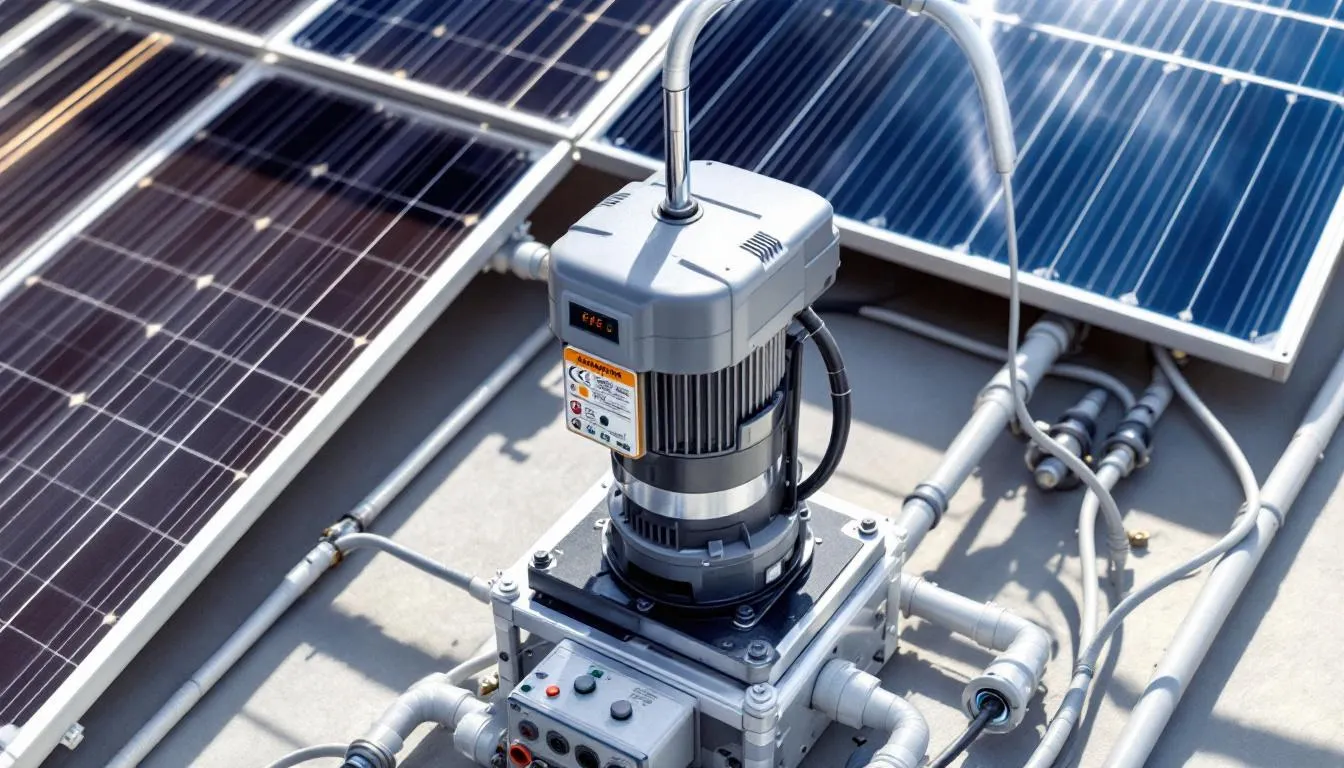
Power management components include inverters and charge controllers that regulate the electrical flow between solar panels and pump motors. Inverters convert DC power from solar panels to AC power when required by the pump motor, while also providing electrical protection and performance optimization features. Charge controllers prevent overcharging and regulate power flow, particularly in systems with battery backup capabilities.
Piping and water management systems transport water from the source to its destination, incorporating valves, fittings, and flow control devices. Proper pipe sizing ensures efficient water flow while minimizing energy losses due to friction. Check valves prevent backflow when the pump stops operating, maintaining water column integrity and reducing restart energy requirements.
Water storage tanks provide essential buffering capacity, allowing water to be pumped during sunny periods and used throughout the day and night. Storage tank sizing typically accommodates 1-3 days of water usage, providing resilience against cloudy weather periods while optimizing system efficiency.
Monitoring and control systems track performance parameters including water flow rates, electrical production, and system health indicators. Modern systems offer remote monitoring capabilities, allowing users to track performance and identify maintenance needs from mobile devices or computers. These systems generate alerts for low water conditions, electrical faults, or maintenance requirements.
Types of Solar Water Pumping Applications
Solar water pumping technology serves diverse applications across residential, agricultural, commercial, and community sectors. Each application type presents unique requirements for flow rates, pumping head, storage capacity, and system reliability.
Solar well pumps represent one of the most common applications, providing groundwater access for rural homes, farms, and remote facilities. These systems typically use submersible pumps installed in drilled wells or boreholes, with solar panels sized to deliver adequate water supply even during winter months when solar irradiation is reduced. Well pump systems often incorporate pressure tanks to maintain consistent water pressure for household use and automatic controllers to prevent dry running when groundwater levels fluctuate.
Solar irrigation systems revolutionize agricultural water management, enabling farmers to maintain crop production during dry seasons and in regions with unreliable rainfall. These systems can be scaled from small garden applications to large-scale commercial farming operations covering hundreds of acres. Drip irrigation integration maximizes water efficiency while solar powered pumps ensure consistent water delivery regardless of grid power availability. Modern agricultural solar pump systems often include soil moisture sensors and automated scheduling to optimize water application timing and quantities.
Solar livestock watering systems provide reliable water access for cattle, horses, and other animals across remote grazing areas. These systems typically use solar powered pumps to fill water troughs or tanks, with float valves maintaining appropriate water levels automatically. Livestock watering applications require robust system design to handle varying water demand patterns and potential damage from animals.
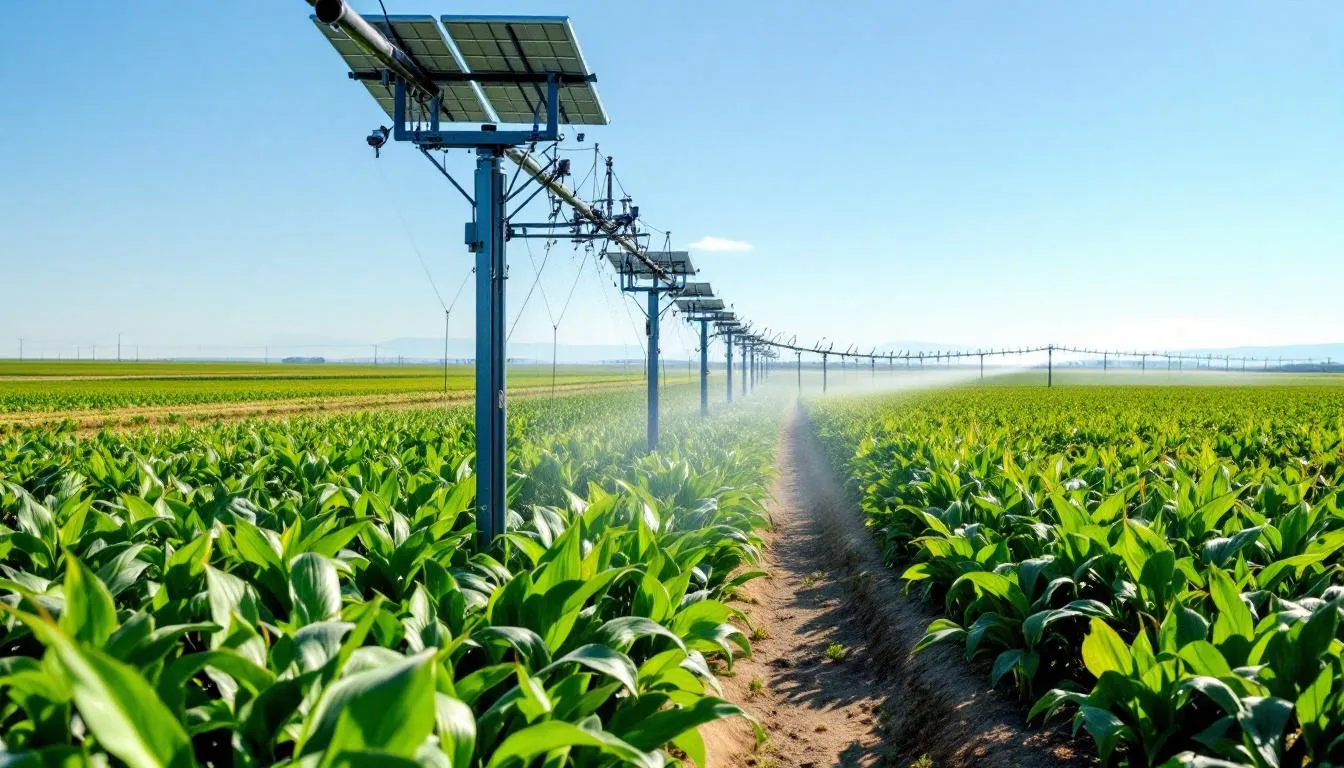
Community water supply projects utilize larger solar pump systems to serve entire villages or neighborhoods, particularly in developing regions where grid electricity is unavailable or unreliable. These projects often incorporate elevated storage tanks to provide gravity-fed water distribution throughout the community. Community systems require careful sizing to handle peak demand periods while maintaining adequate water reserves during extended cloudy weather.
Pool and fountain circulation systems use solar power to maintain water quality and aesthetic appeal without ongoing electricity costs. These applications typically require continuous or frequent pumping during daylight hours, making them well-suited to direct solar power without battery storage. Pool solar pump systems can significantly reduce operating costs while providing reliable water circulation for filtration and chemical distribution.
Industrial and commercial applications include solar powered pumps for construction sites, mining operations, and manufacturing facilities in remote locations. These systems often require higher flow rates and more robust components to handle demanding operating conditions and continuous use requirements.
Benefits of Solar-Powered Water Pumps
Solar powered water pumps deliver compelling advantages across economic, environmental, and operational dimensions, making them increasingly attractive for diverse water pumping applications. These benefits compound over the system’s 20+ year lifespan, providing substantial value to users while supporting broader sustainability goals.
Economic Advantages
The elimination of ongoing electricity costs represents the most immediate economic benefit of solar water pump systems. Traditional grid-powered pumps can generate monthly electricity bills of hundreds or thousands of dollars, depending on pumping requirements and local utility rates. Solar powered pumps eliminate these recurring expenses entirely, with the sun providing free fuel for the system’s entire operational life.
Fuel cost elimination provides even greater savings for users currently operating diesel or gasoline-powered pumps. Diesel fuel costs can exceed $3-5 per gallon in remote areas, with fuel transportation adding additional expenses. Large agricultural operations may consume hundreds of gallons monthly for irrigation pumping, creating substantial ongoing operational costs that solar systems eliminate completely.
Declining solar panel prices have dramatically improved the economic case for solar water pumping. Solar panel costs have dropped over 80% in the past decade, making initial system investments increasingly affordable. This price trend continues as solar manufacturing scales globally and technology efficiency improves, further enhancing the return on investment for solar pump installations.
Long-term return on investment calculations typically show payback periods of 3-7 years for solar water pump systems, depending on local electricity or fuel costs and system size. After the payback period, users enjoy decades of free water pumping, with total savings often exceeding 10 times the initial investment over the system’s lifespan.
Government incentives and rebates further improve economic attractiveness in many regions. Federal tax credits, state rebate programs, and utility incentives can reduce initial system costs by 30-50%, significantly shortening payback periods and improving overall project economics.
Environmental Impact
Solar water pumps produce zero emissions during operation, contributing to carbon footprint reduction and air quality improvement. Traditional diesel pumps emit substantial quantities of carbon dioxide, nitrogen oxides, and particulate matter, contributing to climate change and local air pollution. A typical agricultural diesel pump can produce several tons of CO2 annually, while solar alternatives operate emission-free.
The reduction in fossil fuel consumption supports energy independence and reduces reliance on imported petroleum products. This benefit extends beyond individual users to national energy security and economic stability, particularly in regions heavily dependent on fuel imports for agricultural and rural water needs.
Solar water pump systems avoid the environmental risks associated with fuel storage and handling. Diesel spills can contaminate soil and groundwater, creating long-term environmental damage and cleanup costs. Solar systems eliminate these risks entirely while reducing the transportation impacts associated with regular fuel deliveries to remote locations.
The renewable nature of solar energy ensures long-term sustainability without resource depletion concerns. Unlike fossil fuels, sunlight remains abundant and available for the indefinite future, providing energy security for water pumping applications across multiple decades of system operation.
Operational Benefits
Automatic operation during daylight hours eliminates the need for manual pump starting and monitoring, reducing labor requirements and improving operational convenience. Solar pumps start automatically when sufficient sunlight becomes available and stop when solar irradiation drops below operational thresholds, requiring minimal user intervention for routine operation.
Minimal maintenance requirements reduce ongoing operational complexity and costs compared to internal combustion engines or complex electrical systems. Solar panels require occasional cleaning and periodic inspection, while pump motors need standard maintenance similar to any electric pump. The absence of engines, fuel systems, and complex electrical components simplifies maintenance and reduces the need for specialized technical support.
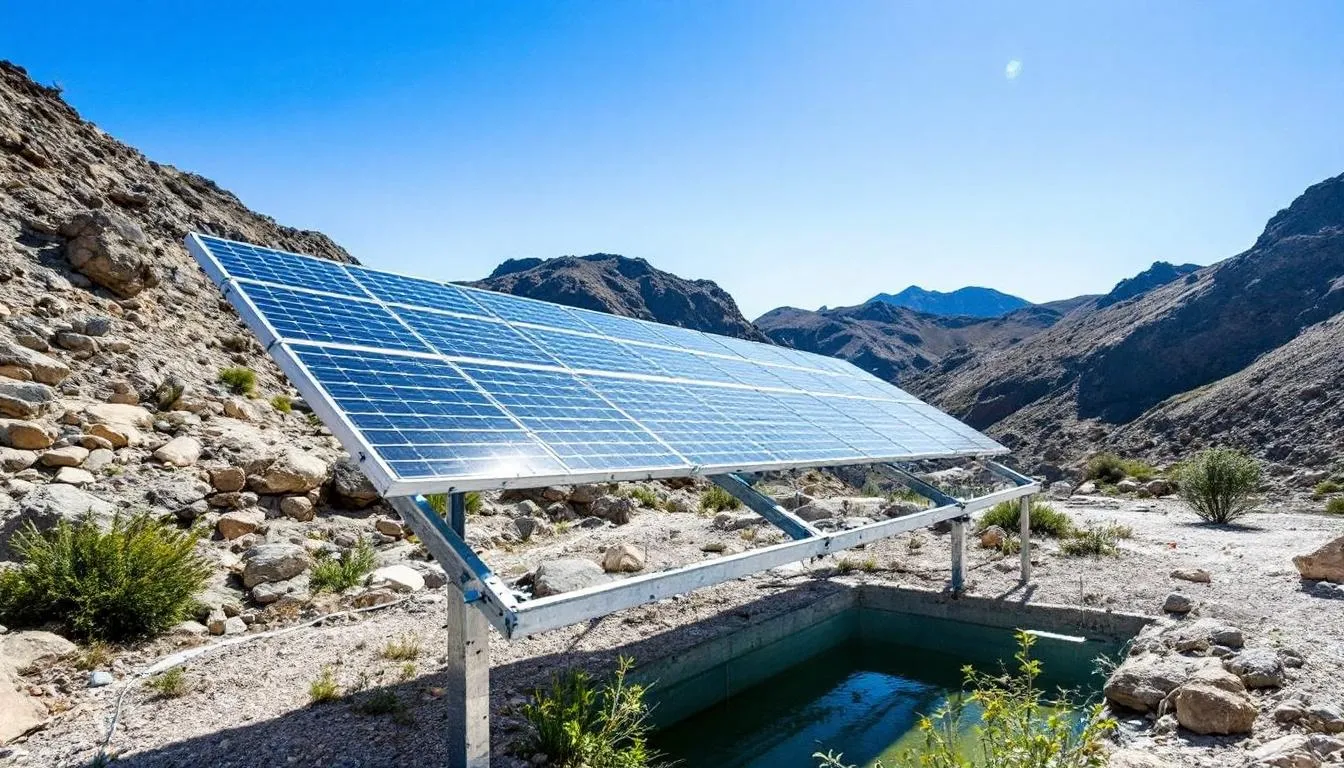
Easy installation without electrical infrastructure makes solar pumps ideal for remote locations where grid power extension would be extremely expensive or impossible. Solar systems can be installed and operational within days, compared to months or years required for electrical grid extensions to remote areas.
Reliable performance in off-grid locations provides water security independent of grid power outages or fuel supply disruptions. This reliability proves particularly valuable for critical applications like livestock watering or community water supply, where pump failure can have serious consequences for animal welfare or human health.
Scalability allows solar pump systems to grow with changing water requirements. Additional solar panels can expand system capacity, while modular design principles enable system upgrades without complete equipment replacement. This flexibility supports evolving needs in agricultural, residential, and commercial applications.
Best Solar Panels for Water Pump Systems
Selecting appropriate solar panels for water pump applications requires careful consideration of power output, efficiency, durability, and warranty coverage to ensure optimal system performance and long-term reliability. The solar panel array represents a significant portion of total system cost while directly determining pumping capacity and overall system effectiveness.
Power output requirements depend on pump motor specifications and daily water demand patterns. Most residential and small agricultural applications require solar panel arrays ranging from 1-5 kilowatts, while larger commercial or community systems may need 10-50 kilowatts or more. Panel selection should account for seasonal variations in solar irradiation, with array sizing typically 20-30% larger than pump motor ratings to ensure adequate power during winter months or less optimal weather conditions.
Efficiency ratings significantly impact system economics and space requirements, particularly for installations with limited available area for panel mounting. High-efficiency monocrystalline panels delivering 20-22% efficiency allow smaller array footprints while maximizing power generation per square foot. While high-efficiency panels cost more per watt, they often provide better value for applications with space constraints or aesthetic considerations.
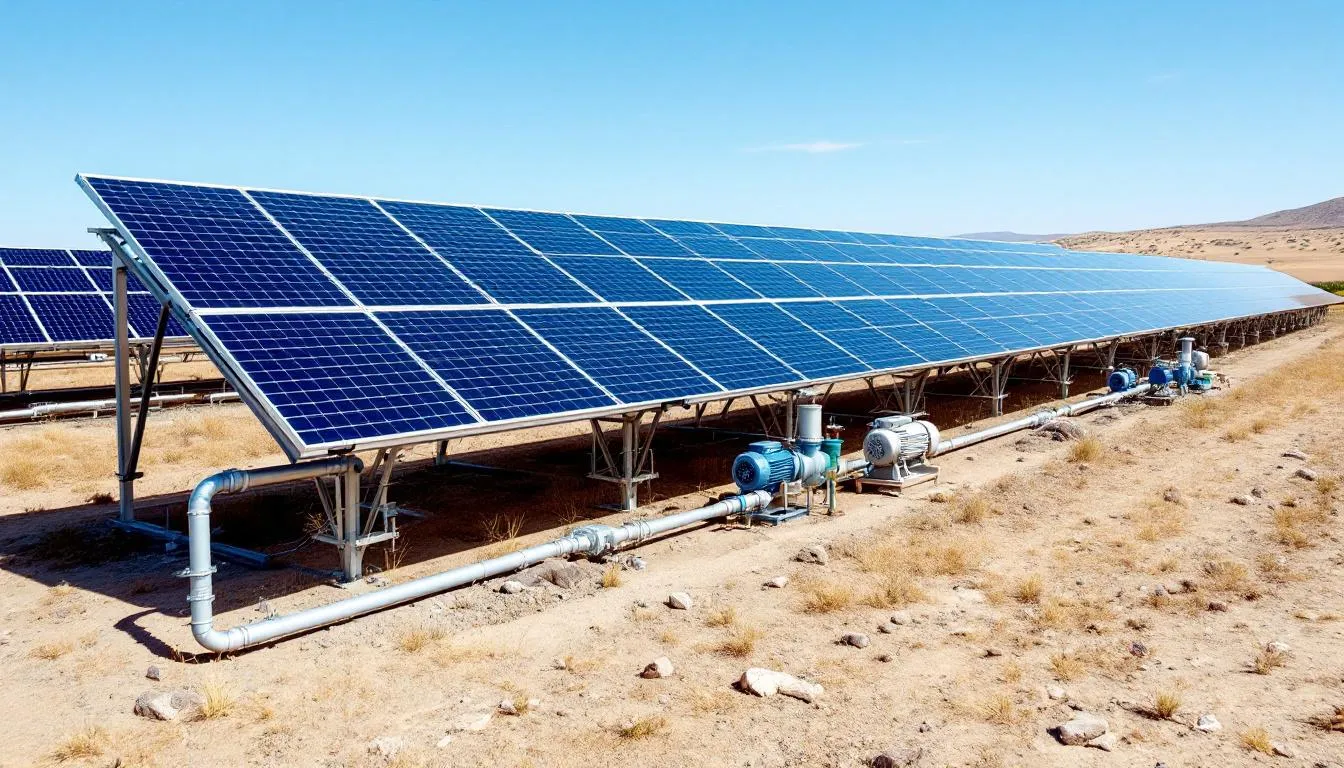
Durability considerations include wind and snow load ratings, corrosion resistance, and impact tolerance for installations in challenging environments. Agricultural and remote installations often face harsh weather conditions, requiring panels rated for high wind speeds and heavy snow loads. Marine-grade installations need enhanced corrosion resistance to withstand salt spray and humidity exposure.
High-Efficiency Solar Panel Options
Premium monocrystalline panels from leading manufacturers offer power outputs exceeding 400 watts per module with efficiency ratings above 20%. These panels incorporate advanced cell technologies including PERC (Passivated Emitter and Rear Cell) designs and half-cell configurations that improve performance under partial shading conditions and high temperature environments.
Temperature coefficient ratings determine how panel performance degrades as operating temperatures increase above standard test conditions. High-quality panels maintain efficiency better in hot climates, with temperature coefficients of -0.35% per degree Celsius or better. This characteristic proves particularly important for solar water pump applications in hot, sunny regions where panels may operate at 60-70°C during peak sunlight hours.
Warranty coverage provides long-term investment protection, with leading manufacturers offering 25-30 year performance warranties guaranteeing 80-85% of rated power output after 25 years. Product warranties typically cover manufacturing defects for 10-15 years, providing protection against premature panel failure due to quality issues.
Bypass diode configurations minimize power losses when individual cells or panel sections experience shading or soiling. Advanced panel designs incorporate multiple bypass diodes to isolate shaded areas while maintaining power output from unaffected sections, improving overall system performance in real-world conditions.
Anti-reflective coatings and tempered glass surfaces maximize light transmission while providing impact resistance against hail, debris, and vandalism. These features prove particularly important for remote installations where panel replacement may be difficult or expensive.
Certification standards including IEC 61215, IEC 61730, and UL 1703 ensure panels meet international safety and performance standards. These certifications validate testing for mechanical stress, electrical safety, and environmental durability under accelerated aging conditions.
Solar Water Pump System Sizing and Installation
Proper system sizing ensures adequate water delivery while optimizing cost-effectiveness and long-term reliability. Sizing calculations must account for daily water requirements, seasonal demand variations, pumping head, solar resource availability, and system efficiency factors to deliver reliable performance throughout the year.
Calculating daily water requirements involves assessing actual usage patterns for the intended application. Residential applications typically require 200-500 gallons daily for household use, while livestock watering may need 30-50 gallons per animal per day. Agricultural irrigation requirements vary dramatically based on crop type, climate, soil conditions, and irrigation method, ranging from 500-5000 gallons per acre per day during peak growing seasons.
Determining solar panel array size requires matching power generation capacity to pump motor consumption while accounting for system losses and seasonal solar variations. Solar irradiation data for the installation location provides the foundation for sizing calculations, with conservative estimates using average winter solar conditions to ensure year-round operation. Array sizing typically requires 1.2-1.5 watts of panel capacity per watt of pump motor rating to account for inverter losses, wiring losses, and reduced solar panel performance due to temperature and aging effects.
Site assessment considerations include solar exposure analysis, water source evaluation, and installation logistics planning. Solar exposure analysis identifies potential shading from trees, buildings, or terrain features that could reduce system performance. Shading during peak sunlight hours can dramatically impact pumping capacity, requiring careful panel placement or tree trimming to optimize solar access.
Water source assessment determines pumping requirements including static water level, drawdown characteristics, and seasonal variations in water availability. Well testing may be required to establish sustainable pumping rates and verify adequate water supply for intended applications. Surface water sources require evaluation of seasonal flow variations and potential intake protection needs.
Professional sizing consultation provides system optimization expertise and ensures compliance with local codes and regulations. Experienced solar installers can optimize component selection, identify potential installation challenges, and provide accurate performance projections based on local conditions and user requirements.
Installation best practices include proper foundation design for panel mounting structures, electrical code compliance, and integration with existing water distribution systems. Ground-mounted arrays require concrete foundations sized for local wind and snow loads, while roof-mounted systems need structural analysis to verify adequate support capacity.
Local permitting requirements vary by jurisdiction but typically include electrical permits, building permits for mounting structures, and well permits for new water source development. Some areas require professional engineer approval for system designs exceeding specific size thresholds or installation in sensitive environmental areas.
Cost Analysis of Solar Water Pump Systems
Understanding the complete financial picture of solar water pump investments requires analysis of initial capital costs, ongoing operational expenses, financing options, and long-term return on investment calculations. These economic factors determine project feasibility and help optimize system configurations for maximum financial benefit.
Initial investment costs for complete solar pump systems range from $3,000-15,000 for residential applications to $50,000-200,000 for large agricultural or community projects. System costs include solar panels (typically 30-40% of total), pump and motor (25-35%), power electronics (15-20%), installation (15-25%), and permits/design (5-10%). Higher-capacity systems generally achieve better per-watt economics due to economies of scale in equipment procurement and installation.
Cost comparison with traditional electric and diesel pumps reveals significant long-term advantages for solar systems despite higher initial investments. Grid-powered pumps may cost $2,000-8,000 initially but generate ongoing electricity costs of $1,000-5,000 annually depending on pumping requirements and local utility rates. Diesel pumps cost $3,000-12,000 initially with fuel costs of $2,000-10,000 annually plus maintenance expenses for engine service.
Financing options make solar water pump systems accessible despite higher upfront costs. Cash purchases provide the best long-term economics by avoiding interest costs and qualifying for full tax credit benefits. Solar loans offer 10-20 year terms with competitive interest rates, often resulting in monthly payments lower than saved electricity or fuel costs. Lease programs require minimal upfront investment but provide lower long-term savings due to ongoing lease payments.
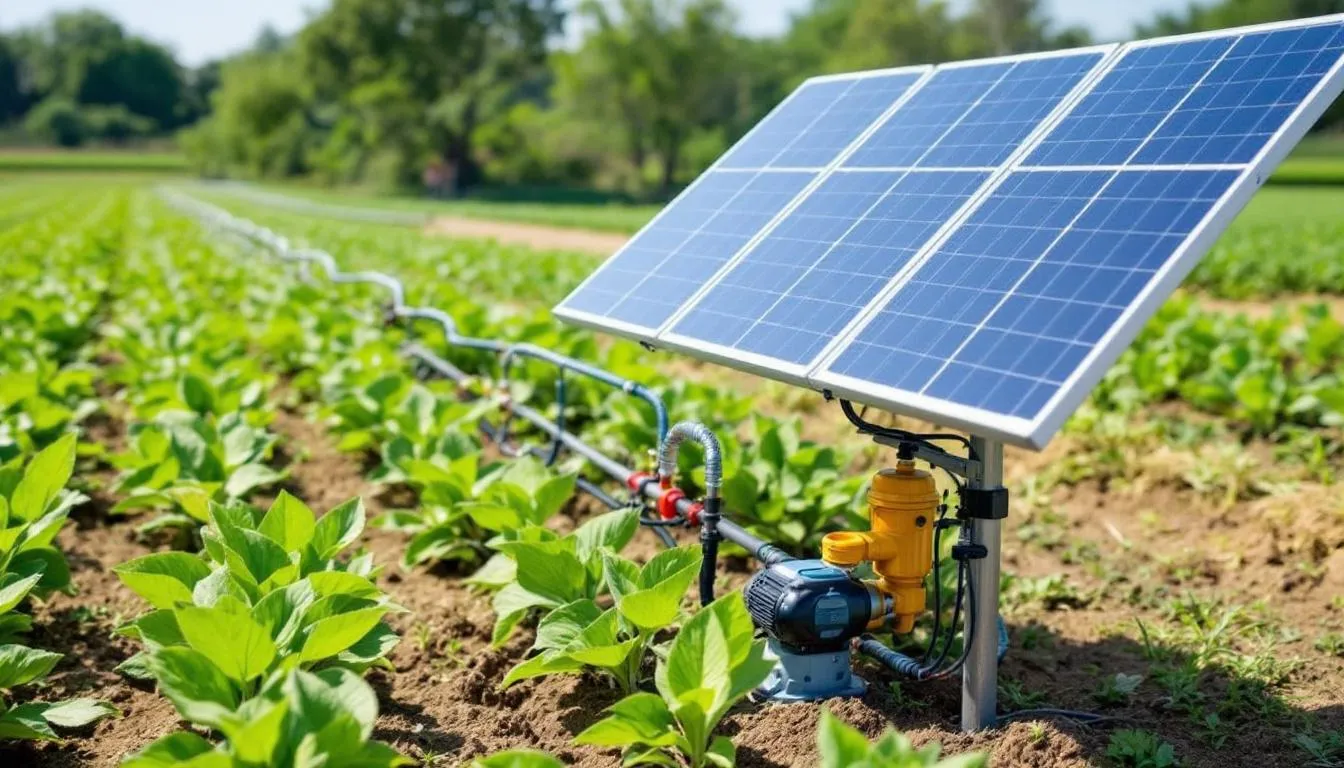
Payback period calculations demonstrate the time required to recover initial investment through energy savings. Typical payback periods range from 3-7 years depending on local energy costs, system size, and available incentives. High fuel cost areas or locations with expensive grid electricity achieve faster payback periods, while areas with low energy costs may require longer payback timeframes.
Total cost of ownership analysis over 20-25 year system lifespans shows dramatic savings compared to conventional pumping alternatives. Solar systems typically save $50,000-500,000 over their operational life compared to diesel pumps, while grid-tied alternatives may save $30,000-200,000 depending on electricity rate escalation and system size.
Available rebates and incentives significantly improve project economics in many regions. Federal solar Investment Tax Credit (ITC) provides 30% tax credit through 2032, reducing net system cost substantially. State rebate programs, utility incentives, and USDA rural development grants can provide additional cost reductions of 20-50% in qualifying areas.
Depreciation benefits for commercial and agricultural installations allow accelerated cost recovery through tax deductions. Modified Accelerated Cost Recovery System (MACRS) schedules permit five-year depreciation for solar energy systems, providing substantial tax benefits for income-producing installations.
Energy cost escalation protection provides additional value as utility rates and fuel prices increase over time. Solar systems lock in energy costs for decades, providing protection against inflation and supply disruptions that affect conventional energy sources. Historical utility rate increases of 3-5% annually compound the long-term savings from solar water pump installations.
Global Impact and Applications
Solar water pump technology plays a transformative role in addressing global water scarcity challenges while supporting sustainable development goals in regions lacking reliable electricity infrastructure. The technology’s impact extends far beyond individual installations to encompass community development, agricultural productivity, and public health improvements across developing nations.
Solar pumps address water scarcity affecting over 2 billion people worldwide who lack access to safely managed drinking water services. Traditional water sources often require manual labor for water collection, consuming hours daily that could otherwise support education, economic activities, or family care. Solar powered pumps automate water delivery, freeing time for productive activities while ensuring consistent access to clean water sources.
Agricultural productivity improvements through reliable irrigation transform rural economies and food security in regions dependent on rainfed agriculture. Small-scale farmers using solar irrigation systems report crop yield increases of 200-300% compared to rainfed cultivation, enabling year-round production and crop diversification. These improvements support household food security while generating surplus production for local markets, creating income opportunities for rural families.
Community health benefits result from improved access to clean water sources and reduced reliance on contaminated surface water or distant wells. Solar pump systems can deliver water from protected groundwater sources or enable treatment and distribution of surface water, reducing waterborne disease transmission that affects millions globally. Reduced water collection time also improves school attendance, particularly for girls who traditionally bear responsibility for household water collection.
The role in achieving Sustainable Development Goals (SDGs) includes direct contributions to SDG 6 (Clean Water and Sanitation), SDG 7 (Affordable and Clean Energy), and SDG 13 (Climate Action). Solar water pump projects demonstrate practical approaches to sustainable development that address multiple goals simultaneously while building local capacity for technology maintenance and operation.
Support for rural populations includes approximately 80% of the world’s poor who live in rural areas with limited access to electricity infrastructure. Solar water pump installations provide immediate benefits without requiring extensive infrastructure development, making them particularly suitable for remote communities where grid extension costs would be prohibitive.
International development organizations including the World Bank, United Nations agencies, and NGOs increasingly prioritize solar water pump projects as cost-effective interventions for rural development. These organizations report success rates exceeding 80% for properly designed and maintained solar pump installations, compared to 60% or lower for diesel-powered alternatives that face fuel supply and maintenance challenges.
Technology transfer and local capacity building accompany many solar pump installations, providing training for local technicians and establishing supply chains for replacement parts and ongoing maintenance. These programs create local employment opportunities while ensuring long-term system sustainability through community ownership and technical competency.
Maintenance and Troubleshooting
Effective maintenance practices ensure optimal performance and maximize the 20+ year lifespan potential of solar water pump systems. Preventive maintenance requirements remain minimal compared to diesel or grid-powered alternatives, focusing primarily on solar panel care, electrical system inspection, and pump motor service according to manufacturer recommendations.
Regular maintenance schedules typically include monthly visual inspections, quarterly detailed system checks, and annual professional service visits. Monthly inspections focus on solar panel cleanliness, visible damage to system components, water flow verification, and controller status indicators. Users can perform these basic checks without specialized tools or technical expertise, making them suitable for remote installations with limited technical support.
Solar panel cleaning procedures vary based on local environmental conditions but generally require monthly cleaning in dusty environments and quarterly cleaning in moderate climates. Cleaning involves removing dust, bird droppings, and debris using soft brushes and clean water, avoiding abrasive materials or harsh chemicals that could damage anti-reflective coatings. Automated cleaning systems are available for large installations where manual cleaning would be impractical.
Pump motor maintenance follows standard practices for electric motors, including bearing lubrication, electrical connection inspection, and performance monitoring. Submersible pumps require periodic inspection of well casings and water level monitoring to prevent dry running conditions that can damage motor windings. Surface pumps need regular inspection of suction lines, check valves, and mechanical seals to maintain optimal performance.
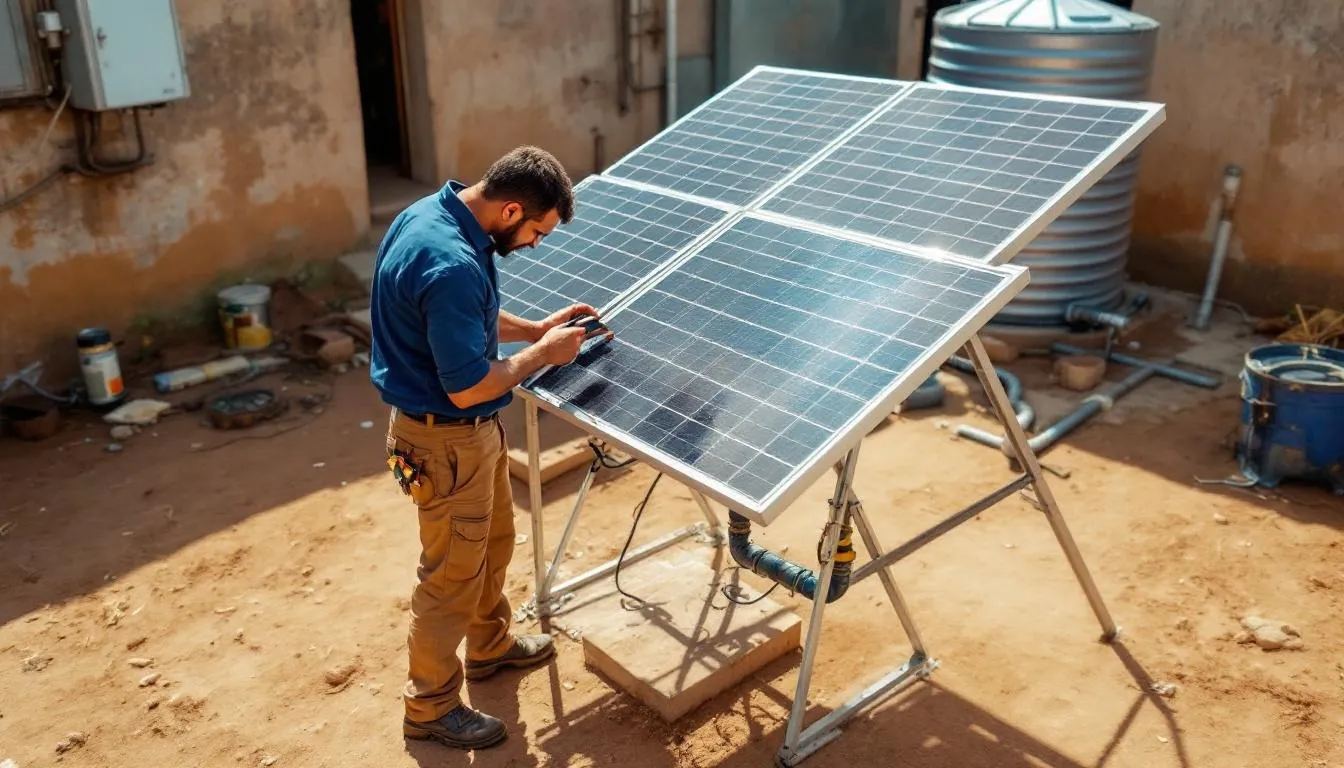
Common issues include reduced water flow due to pump wear or well problems, electrical faults from loose connections or component failure, and performance degradation from soiled solar panels or shading. Troubleshooting guides help users identify and resolve simple problems while recognizing situations requiring professional service.
Performance monitoring systems track key parameters including daily water production, solar panel voltage and current, and pump motor performance indicators. Modern systems provide remote monitoring capabilities through cellular or satellite communications, enabling proactive maintenance scheduling and rapid problem identification.
Professional service requirements include annual electrical system inspection, pump performance testing, and component replacement as needed. Qualified technicians can identify potential problems before they cause system failures while optimizing performance through system adjustments and component upgrades.
Warranty support from reputable manufacturers provides protection against premature component failure while ensuring access to replacement parts throughout the system’s operational life. Extended warranty programs offer additional protection for critical components like inverters and pump motors that may require replacement during the system’s lifespan.
Seasonal maintenance considerations include winter shutdown procedures in freezing climates, spring startup inspections, and summer performance optimization during peak demand periods. Proper seasonal maintenance prevents freeze damage while ensuring maximum water production during high-demand periods.
Component replacement schedules help users plan for predictable maintenance costs over the system’s lifetime. Solar panels typically require no replacement for 25+ years, while inverters may need replacement after 10-15 years and pump motors after 15-20 years depending on operating conditions and usage patterns.
Training programs for local technicians support long-term system sustainability, particularly for community installations in remote areas. These programs cover basic electrical troubleshooting, pump maintenance, and safety procedures while establishing local expertise for routine service needs.
Conclusion
Solar power for water pump systems represent a transformative technology that addresses critical water access challenges while delivering substantial economic and environmental benefits. From small residential wells to large agricultural irrigation projects, solar powered pumps provide reliable, cost-effective water solutions that eliminate ongoing fuel and electricity costs while supporting sustainable development goals.
The compelling economics of solar water pumping continue improving as solar panel prices decline and system efficiency increases. With payback periods typically ranging from 3-7 years and operational lifespans exceeding 20 years, these systems deliver exceptional long-term value compared to conventional pumping alternatives. The elimination of monthly electricity bills and fuel costs provides immediate cash flow benefits that compound over decades of operation.
Environmental benefits extend beyond individual installations to support broader climate goals and sustainable resource management. Solar water pumps operate emission-free while reducing dependence on fossil fuels and supporting renewable energy adoption in agricultural and rural applications. These systems demonstrate practical approaches to sustainable development that can be replicated globally.
The global impact of solar water pump technology continues expanding as costs decline and technology improves. From enabling agricultural productivity in sub-Saharan Africa to providing reliable water access in remote communities worldwide, solar pumps support human development while building resilience against climate change impacts.
For property owners, farmers, and communities considering water pumping solutions, solar technology offers a proven path to energy independence and long-term cost savings. The combination of declining equipment costs, improving efficiency, and available financing options makes solar water pumps increasingly accessible for diverse applications and budgets.
Professional consultation ensures optimal system design and installation for maximum performance and reliability. Working with experienced solar installers and pump specialists helps navigate technical considerations, permitting requirements, and financing options while ensuring systems meet specific water requirements and site conditions.
The future of water pumping increasingly points toward solar solutions as technology advances and costs continue declining. Early adopters benefit from immediate cost savings and energy independence while contributing to broader adoption of sustainable water infrastructure that will serve communities for decades to come.

